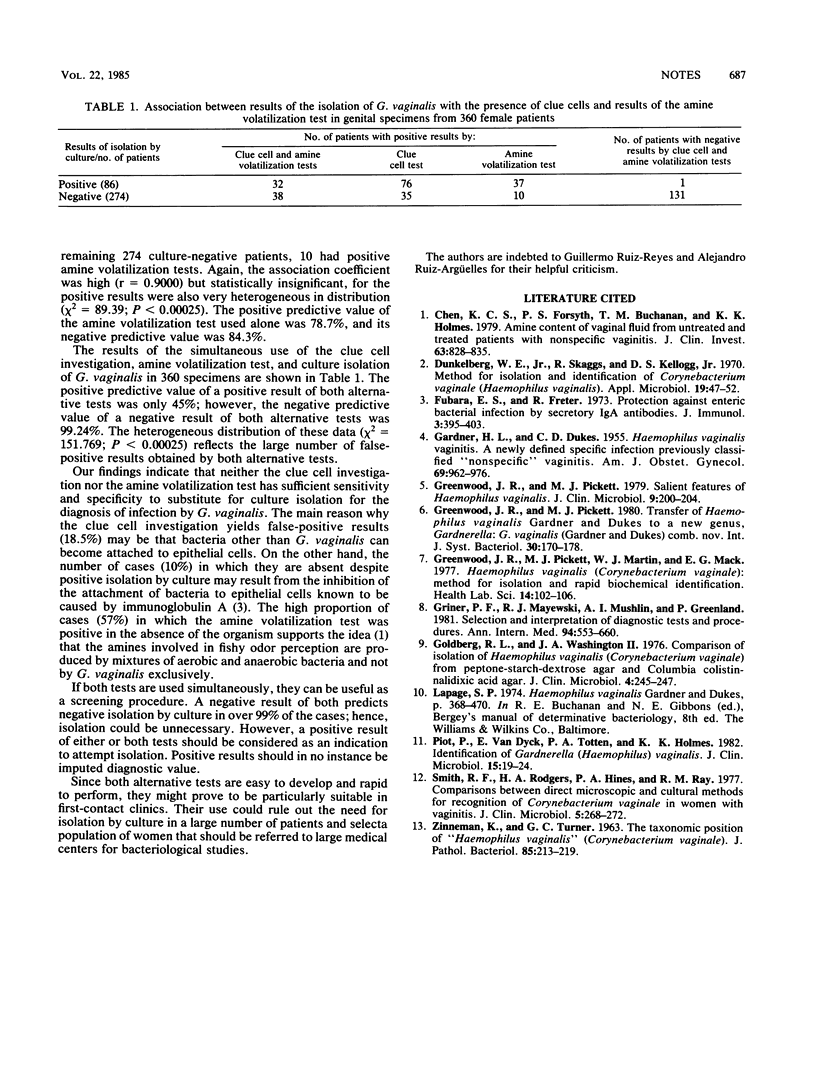Abstract
Although still controversial, an etiologic role of Gardnerella vaginalis is imputed in vaginitis. Besides isolation of the organism by culture, two alternative diagnostic procedures have been claimed to be useful: the investigation of "clue cells" in clinical specimens and the amine volatilization test or fishy odor perception in genital secretions. Herein we report on the findings of the simultaneous use of G. vaginalis isolation, the clue cell test and amine volatilization perception in specimens from 1,263 consecutive female patients referred to our clinic. Our results show that the simultaneous use of both alternative tests is very useful as a screening procedure. A negative result of both tests predicts a negative culture result in 99% of the cases. However, a positive result of either or both should be considered as an indication to proceed to culture and not as diagnostic of infection.
Full text
PDF

Selected References
These references are in PubMed. This may not be the complete list of references from this article.
- Chen K. C., Forsyth P. S., Buchanan T. M., Holmes K. K. Amine content of vaginal fluid from untreated and treated patients with nonspecific vaginitis. J Clin Invest. 1979 May;63(5):828–835. doi: 10.1172/JCI109382. [DOI] [PMC free article] [PubMed] [Google Scholar]
- Dunkelberg W. E., Jr, Skaggs R., Kellogg D. S., Jr Method for isolation and identification of Corynebacterium vaginale (Haemophilus vaginalis). Appl Microbiol. 1970 Jan;19(1):47–52. doi: 10.1128/am.19.1.47-52.1970. [DOI] [PMC free article] [PubMed] [Google Scholar]
- Fubara E. S., Freter R. Protection against enteric bacterial infection by secretory IgA antibodies. J Immunol. 1973 Aug;111(2):395–403. [PubMed] [Google Scholar]
- GARDNER H. L., DUKES C. D. Haemophilus vaginalis vaginitis: a newly defined specific infection previously classified non-specific vaginitis. Am J Obstet Gynecol. 1955 May;69(5):962–976. [PubMed] [Google Scholar]
- Golberg R. L., Washington JA I. I. Comparison of isolation of Haemophilus vaginalis (Corynebacterium vaginale) from peptone-starch-dextrose agar and Columbia colistin-nalidoxic acid agar. J Clin Microbiol. 1976 Sep;4(3):245–247. doi: 10.1128/jcm.4.3.245-247.1976. [DOI] [PMC free article] [PubMed] [Google Scholar]
- Greenwood J. R., Pickett M. J., Martin W. J., Mack E. G. Heamophilus vaginalis (Corynebacterium vaginal): method for isolation and rapid biochemical identification. Health Lab Sci. 1977 Apr;14(2):102–106. [PubMed] [Google Scholar]
- Greenwood J. R., Pickett M. J. Salient features of Haemophilus vaginalis. J Clin Microbiol. 1979 Feb;9(2):200–204. doi: 10.1128/jcm.9.2.200-204.1979. [DOI] [PMC free article] [PubMed] [Google Scholar]
- Piot P., Van Dyck E., Totten P. A., Holmes K. K. Identification of Gardnerella (Haemophilus) vaginalis. J Clin Microbiol. 1982 Jan;15(1):19–24. doi: 10.1128/jcm.15.1.19-24.1982. [DOI] [PMC free article] [PubMed] [Google Scholar]
- Smith R. F., Rodgers H. A., Hines P. A., Ray R. M. Comparisons between direct microscopic and cultural methods for recognition of Corynebacterium vaginale in women with vaginitis. J Clin Microbiol. 1977 Mar;5(3):268–272. doi: 10.1128/jcm.5.3.268-272.1977. [DOI] [PMC free article] [PubMed] [Google Scholar]


